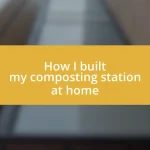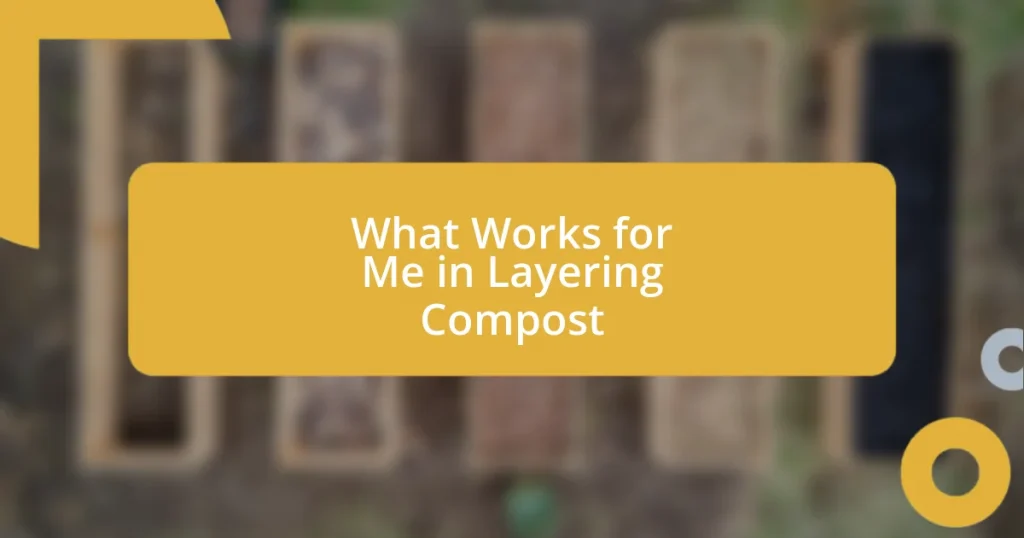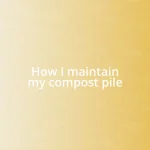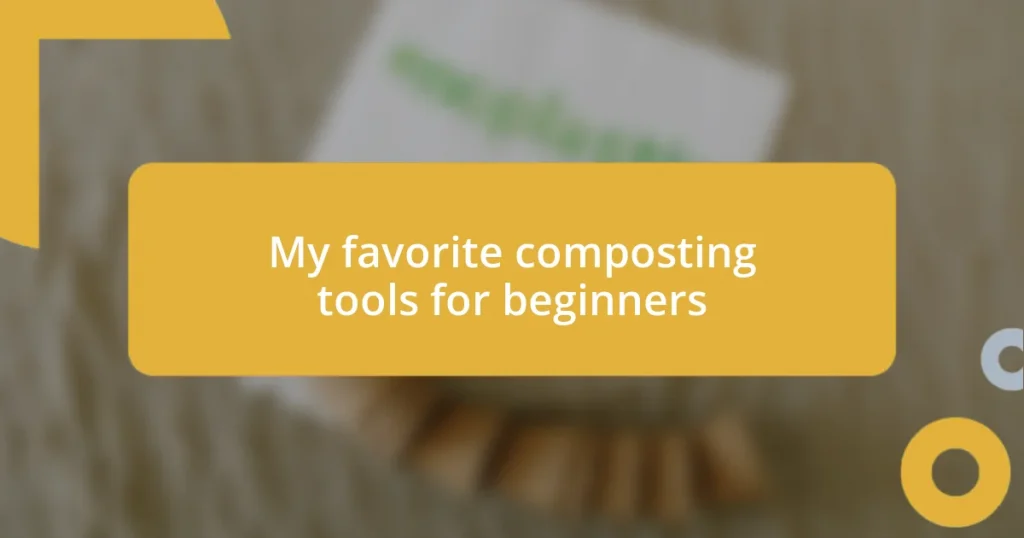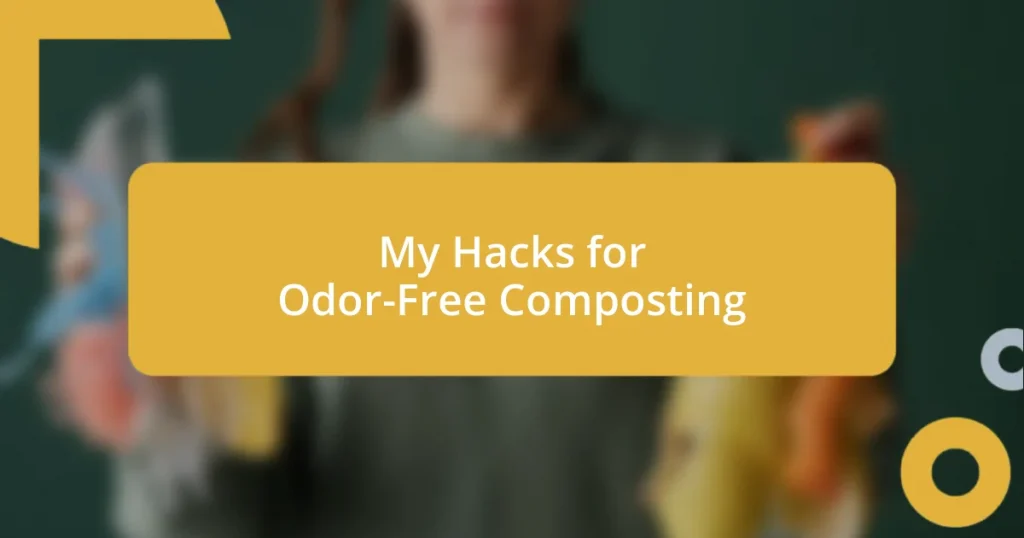Key takeaways:
- Understanding the balance between “greens” (nitrogen-rich) and “browns” (carbon-rich) is crucial for effective composting, enhancing aeration and nutrient balance.
- Maintaining ideal layer thickness (3-4 inches) and moisture levels helps to create a thriving compost ecosystem, speeding up decomposition while preventing odors and compacting.
- Regularly turning the compost every 2-4 weeks improves air circulation and integrates layers, fostering a healthy environment for microorganisms and accelerating the breakdown process.

Understanding Compost Layers
When I first started composting, I was surprised to learn that not all materials contribute equally to a thriving compost pile. Compost layers typically consist of greens, like kitchen scraps, and browns, such as dried leaves or cardboard. Understanding the balance between these layers feels crucial, doesn’t it? Achieving the right mix not only speeds up decomposition but also enriches the final compost.
As I began layering my compost, I quickly discovered the magic of the “lasagna” approach. This method involves alternating layers in a way that mimics the natural progression of organic matter in nature. It’s like creating a delicious recipe—too much of one ingredient can throw off the whole dish! Watching my compost transform from vegetable peels and grass clippings into dark, crumbly dirt was truly rewarding.
One of my most memorable experiences was finding just the right moment to turn my compost. The satisfaction of seeing steam rise as I mixed those layers felt like a little victory. It’s amazing how, with just a handful of effort and some knowledge about layering, you can harness nature’s processes and contribute to a healthier garden. Have you ever noticed how a well-layered compost pile seems more alive? It’s those vibrant interactions that create a thriving ecosystem right in your backyard.

Benefits of Layering Compost
Layering compost offers a multitude of benefits that I’ve come to appreciate over the years. First and foremost, it promotes better aeration within the pile. I remember when I used to just dump everything in a heap; it would become dense and compact. Since I started layering, I’ve noticed how the air circulates more freely, making decomposition happen faster and more efficiently.
Another significant advantage is the improved balance of nutrients. By alternating greens and browns, my compost has developed a richer nutrient profile. Once, I used to throw in too many grass clippings, and it resulted in a foul smell and slimy texture. After I learned to layer appropriately, my compost not only smelled like earthy goodness but also gave me a rich, dark soil that my plants thrive on.
Lastly, layering keeps undesirable pests at bay. I recall an early composting disaster where I discovered fruit flies swarming all over the top of my pile. I now understand that covering food scraps with brown materials acts as a barrier, reducing attraction for pests significantly. I’ve found peace of mind knowing that my compost system is healthier and more balanced, leading to wonderful gardening results.
| Benefit | Personal Experience |
|---|---|
| Better Aeration | Noticed quicker decomposition and healthier compost after layering instead of just dumping. |
| Balanced Nutrients | Richer compost led to thriving plants after switching to an alternating layer strategy. |
| Pest Control | Reduced pests significantly by covering food scraps with brown materials. |

Best Materials for Compost Layers
When selecting materials for compost layers, I’ve found it’s all about striking the right balance between “greens” and “browns.” Greens are rich in nitrogen, providing the fuel for microbes, while browns add carbon to the mix, helping to build structure in the compost. I remember one of my early composting attempts where I overloaded my pile with kitchen scraps, only to be met with a slimy mess. The lesson I took away from that experience was invaluable: I now make it a point to maintain that essential balance.
Here’s a handy list of some of the best materials I’ve used for each layer:
Greens (Nitrogen-Rich):
– Fruit and vegetable scraps
– Coffee grounds
– Grass clippings
Browns (Carbon-Rich):
– Dried leaves
– Small branches and twigs
– Shredded cardboard
Finding the right materials has not only improved the quality of my compost but also made the process feel more like a fulfilling, creative endeavor. It’s rewarding to watch the slow transformation take place, knowing I’m giving the garden a rich, nutrient-packed soil that nurtures my plants and my spirit.

Ideal Layer Thickness for Compost
When it comes to ideal layer thickness for compost, I’ve found that about 3 to 4 inches for each layer works well. This depth strikes a balance, ensuring that air can circulate without becoming overly compact. I still remember my initial overzealous attempt, layering much thicker, thinking more would be better—only to be met with a soggy, anaerobic disaster. Lesson learned!
I also like to think of layering as a visual guide. When I see these distinct layers of greens and browns forming, it gives me a sense of accomplishment. If one layer starts to look thinner than the others, I make a quick assessment. Do I need more carbon? Or perhaps it’s time to add some fresh kitchen scraps? Adjusting the thickness has truly turned composting into a thoughtful, mindful practice.
Ultimately, I believe that finding the right thickness can help speed up the decomposition process while keeping the conditions optimal for bacteria and worms. A well-maintained thickness may just be one of those “little things” that can make a big difference. Have you noticed how simply tweaking minor details can lead to significant improvements? It’s fascinating how nature responds so positively to our efforts!

Maintaining Moisture in Compost
Maintaining moisture in compost is crucial for creating that thriving ecosystem we all aim for. During my composting journey, I’ve noticed that keeping the pile damp, much like a wrung-out sponge, really helps the decomposition process flourish. I remember one particularly dry summer when I neglected my pile—it was like watching a garden wilt—nothing was breaking down, and I felt a bit defeated.
I’ve since learned that the materials I choose play a big role in moisture retention. After a few experiments, I found that adding materials like shredded newspaper or straw not only helps absorb moisture but also creates air pockets for aerobic bacteria. It really struck me how those seemingly simple additions transformed the texture of my compost. Sometimes, I even give it a gentle sprinkling with the hose—just enough to keep things lively without saturating the mix. Have you ever found yourself in a similar situation, wondering how a little adjustment could yield better results?
Don’t underestimate the importance of monitoring your compost’s moisture level. I check frequently, especially in changing weather. It’s always a balancing act—too wet, and you risk a smelly mess; too dry, and everything grinds to a halt. I once left my pile unattended for too long and faced the unpleasant task of revitalizing it. Now, I pour a little water if it feels dry, mixing it in with a pitchfork to distribute it evenly. This balance between moisture and air has made a world of difference, turning my compost into a living, breathing phenomenon that invigorates my garden.

How to Turn Compost Layers
Turning those compost layers isn’t just about mixing; it’s about cultivating the right environment for decomposition to thrive. I remember the first time I turned my compost pile; it was like discovering a hidden treasure. As I dug in with my pitchfork, the earthy aroma enveloped me, and I felt connected to the very nature of growth. Each turn integrates layers, enhancing air circulation and speeding up breakdown. I often wonder—how often do you get that chance to witness nature’s magic unfold right under your hands?
When I turn the layers, I like to focus on the textures. The contrasting colors of browns and greens transform into a melange of rich, dark material with each rotation. I’ve learned to be gentle yet thorough. I’d once been too aggressive, disrupting the delicate web of organisms that were working hard to break down the matter. The result? An unbalanced pile that took ages to recover. It’s almost therapeutic to witness the vibrant life within the compost. Have you ever paused to appreciate the variety of life you’re nurturing?
Timing also plays a critical role in how I approach turning my compost. I try to turn it every 2-4 weeks, depending on the temperature and moisture levels. This schedule isn’t just arbitrary; it’s about giving the microorganisms time to work their magic between turns. In spring, I remember being extra vigilant, eager to prepare my garden for planting. The anticipation to see that black gold materialize into nutrient-rich compost gives me a sense of fulfillment. I’ve realized that this simple act of turning isn’t just maintenance; it’s a partnership with the natural world. How do you engage with your compost?

Troubleshooting Compost Layer Issues
When layers in my compost seem off-balance, I dive right into troubleshooting. One of the first things I check is the ratio of greens to browns. I once mixed in too much grass clippings with little carbon-rich material, and the pile turned into a mushy mess. That was a tough lesson—finding that ideal balance is essential, and I now keep a close eye on my ratios to prevent rot instead of rich compost.
Another common issue is the smell. If my compost starts to emit an unpleasant odor, I’ve learned that it usually means it’s too wet or compacted. Last summer, I faced a smelly pile, and I felt defeated, like I had failed in my composting mission. But a simple fix was at hand: I added dry leaves and gave it a good turn to aerate the mixture. It felt like I had breathed new life into my compost! Have you ever experienced that moment when you realize that a small adjustment can restore harmony?
Lastly, I can’t stress enough the importance of being patient and observing the composting process. I remember feeling impatient when my compost didn’t seem to break down fast enough. I’d make frequent checks, and sometimes I’d jump the gun by adding more material too soon. Now, I trust the process a bit more. It’s a dance of sorts—nature has its rhythm, and I’ve learned to wait for my compost to find its groove. Have you ever felt that blend of anticipation and patience while nurturing your compost layers? The satisfaction of watching my compost transform over time is one of my greatest joys.






